Financial Decision Making: An Analysis of Skanska PLC (Report)
VerifiedAdded on 2022/11/30
|13
|3403
|208
Report
AI Summary
This report provides a comprehensive financial analysis of Skanska PLC, examining the roles of its accounting and finance departments. The analysis includes an overview of the accounting department's functions, such as financial accounting (balance sheet, income statement, and cash flow statement), management accounting, tax, and audit functions. The report also details the responsibilities of the finance department, covering investment decisions, financing, dividend policies, and working capital management. Furthermore, the report uses ratio analysis to assess Skanska PLC's financial performance, including calculations and interpretations of the Return on Capital Employed (ROCE), net profit margin, current ratio, debtors collection period, and creditor collection period for the years 2018 and 2019. The report concludes with recommendations for improving financial performance based on the ratio analysis.

Financial Decision
Making
Making
Paraphrase This Document
Need a fresh take? Get an instant paraphrase of this document with our AI Paraphraser
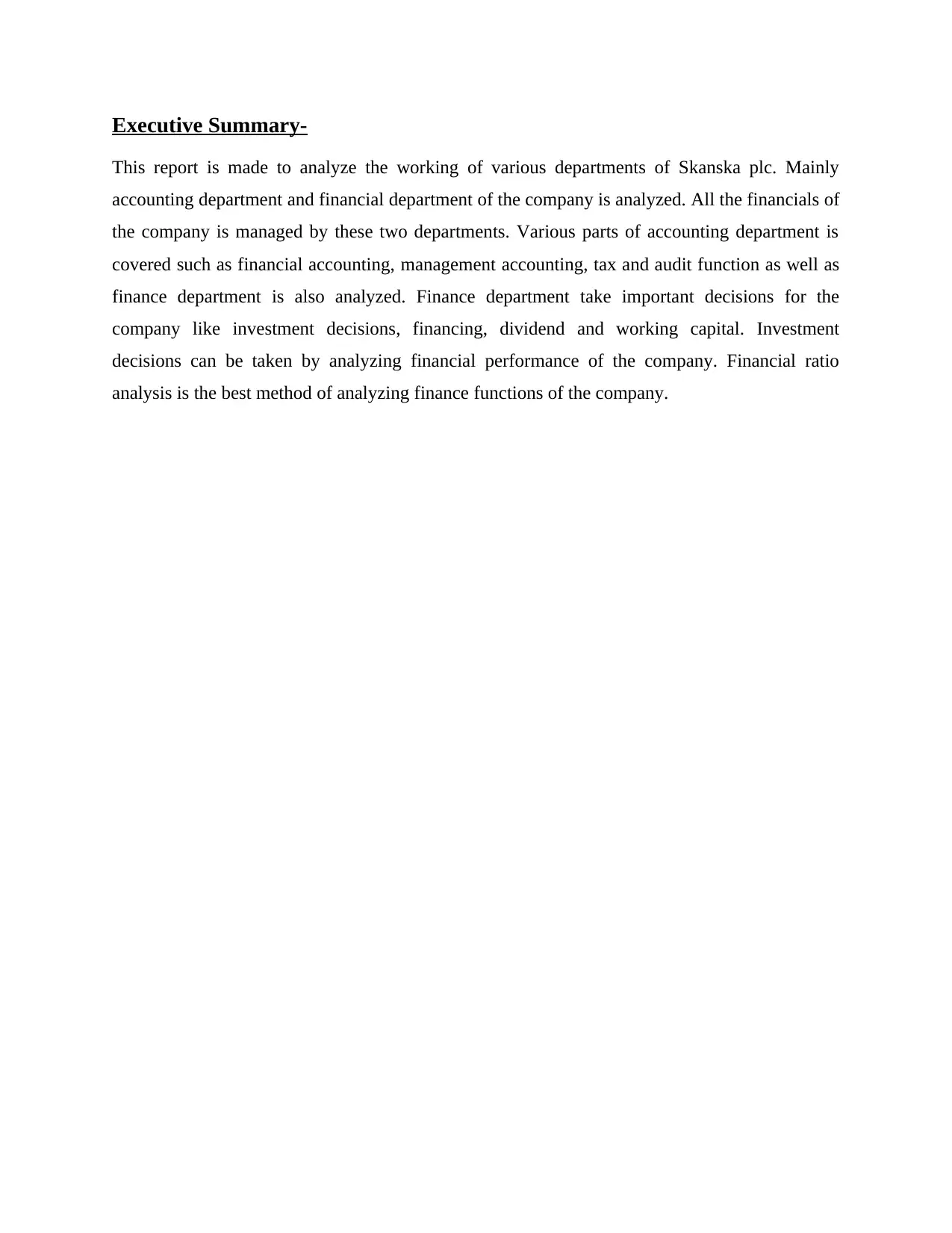
Executive Summary-
This report is made to analyze the working of various departments of Skanska plc. Mainly
accounting department and financial department of the company is analyzed. All the financials of
the company is managed by these two departments. Various parts of accounting department is
covered such as financial accounting, management accounting, tax and audit function as well as
finance department is also analyzed. Finance department take important decisions for the
company like investment decisions, financing, dividend and working capital. Investment
decisions can be taken by analyzing financial performance of the company. Financial ratio
analysis is the best method of analyzing finance functions of the company.
This report is made to analyze the working of various departments of Skanska plc. Mainly
accounting department and financial department of the company is analyzed. All the financials of
the company is managed by these two departments. Various parts of accounting department is
covered such as financial accounting, management accounting, tax and audit function as well as
finance department is also analyzed. Finance department take important decisions for the
company like investment decisions, financing, dividend and working capital. Investment
decisions can be taken by analyzing financial performance of the company. Financial ratio
analysis is the best method of analyzing finance functions of the company.
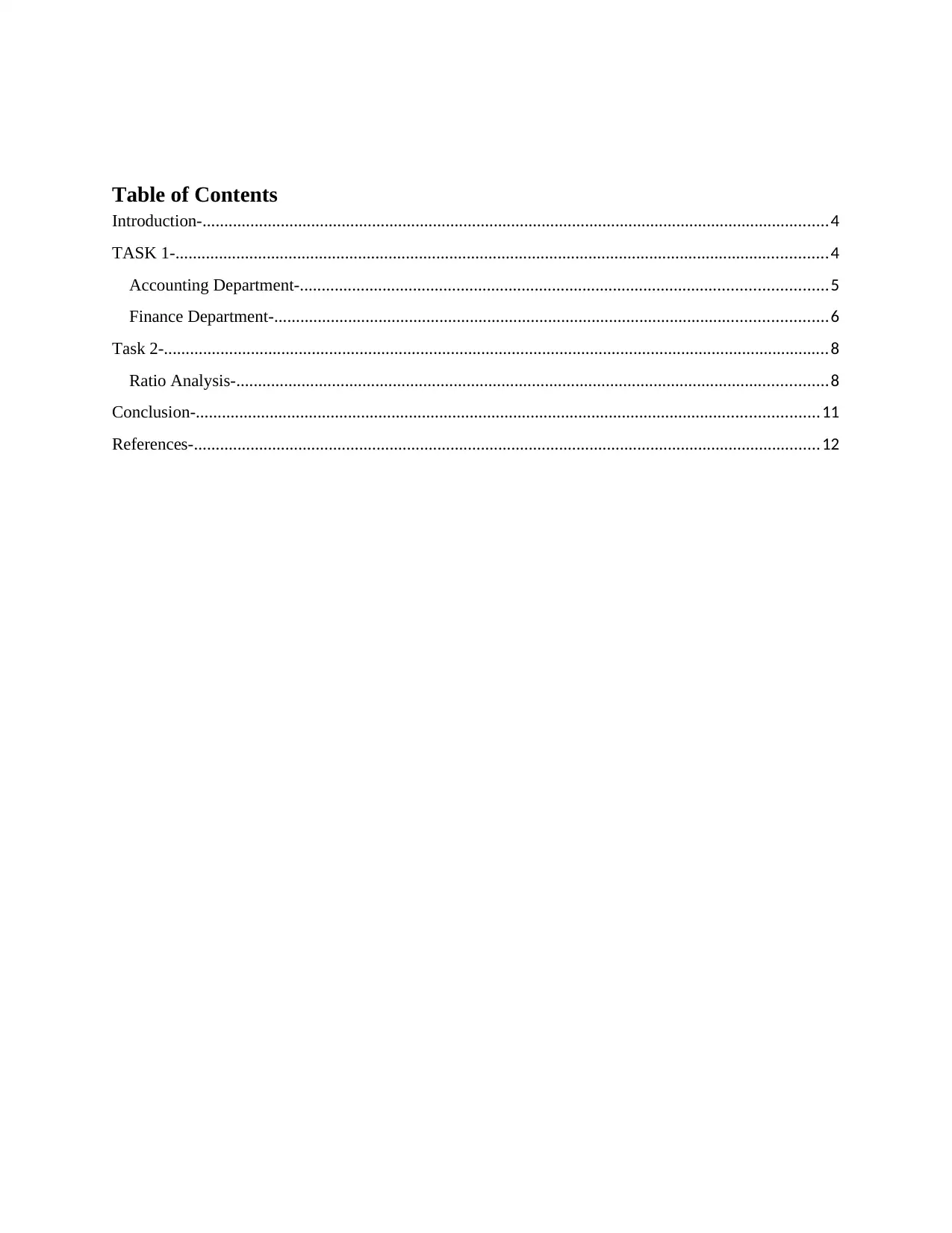
Table of Contents
Introduction-................................................................................................................................................4
TASK 1-......................................................................................................................................................4
Accounting Department-.........................................................................................................................5
Finance Department-...............................................................................................................................6
Task 2-.........................................................................................................................................................8
Ratio Analysis-........................................................................................................................................8
Conclusion-...............................................................................................................................................11
References-................................................................................................................................................12
Introduction-................................................................................................................................................4
TASK 1-......................................................................................................................................................4
Accounting Department-.........................................................................................................................5
Finance Department-...............................................................................................................................6
Task 2-.........................................................................................................................................................8
Ratio Analysis-........................................................................................................................................8
Conclusion-...............................................................................................................................................11
References-................................................................................................................................................12
⊘ This is a preview!⊘
Do you want full access?
Subscribe today to unlock all pages.

Trusted by 1+ million students worldwide
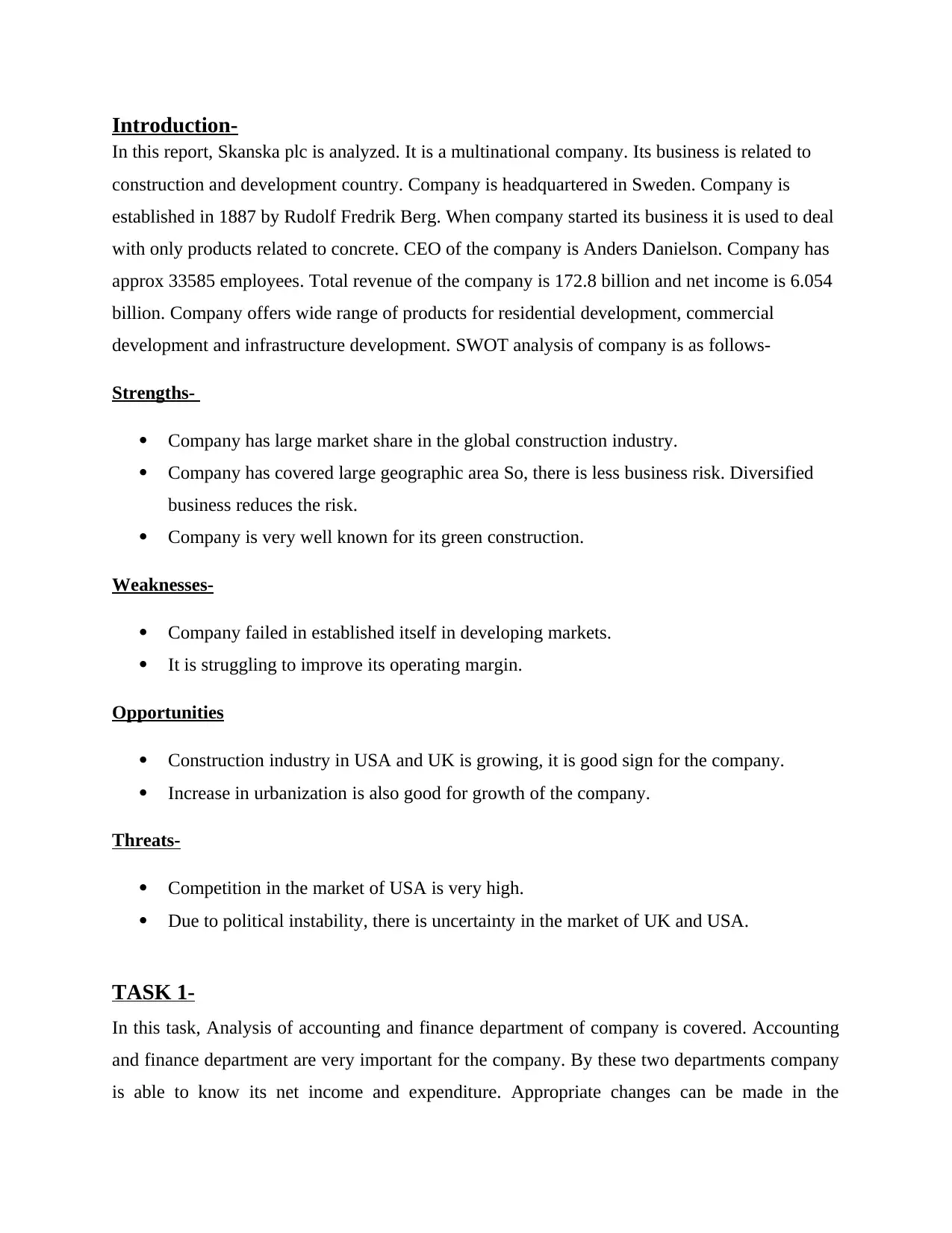
Introduction-
In this report, Skanska plc is analyzed. It is a multinational company. Its business is related to
construction and development country. Company is headquartered in Sweden. Company is
established in 1887 by Rudolf Fredrik Berg. When company started its business it is used to deal
with only products related to concrete. CEO of the company is Anders Danielson. Company has
approx 33585 employees. Total revenue of the company is 172.8 billion and net income is 6.054
billion. Company offers wide range of products for residential development, commercial
development and infrastructure development. SWOT analysis of company is as follows-
Strengths-
Company has large market share in the global construction industry.
Company has covered large geographic area So, there is less business risk. Diversified
business reduces the risk.
Company is very well known for its green construction.
Weaknesses-
Company failed in established itself in developing markets.
It is struggling to improve its operating margin.
Opportunities
Construction industry in USA and UK is growing, it is good sign for the company.
Increase in urbanization is also good for growth of the company.
Threats-
Competition in the market of USA is very high.
Due to political instability, there is uncertainty in the market of UK and USA.
TASK 1-
In this task, Analysis of accounting and finance department of company is covered. Accounting
and finance department are very important for the company. By these two departments company
is able to know its net income and expenditure. Appropriate changes can be made in the
In this report, Skanska plc is analyzed. It is a multinational company. Its business is related to
construction and development country. Company is headquartered in Sweden. Company is
established in 1887 by Rudolf Fredrik Berg. When company started its business it is used to deal
with only products related to concrete. CEO of the company is Anders Danielson. Company has
approx 33585 employees. Total revenue of the company is 172.8 billion and net income is 6.054
billion. Company offers wide range of products for residential development, commercial
development and infrastructure development. SWOT analysis of company is as follows-
Strengths-
Company has large market share in the global construction industry.
Company has covered large geographic area So, there is less business risk. Diversified
business reduces the risk.
Company is very well known for its green construction.
Weaknesses-
Company failed in established itself in developing markets.
It is struggling to improve its operating margin.
Opportunities
Construction industry in USA and UK is growing, it is good sign for the company.
Increase in urbanization is also good for growth of the company.
Threats-
Competition in the market of USA is very high.
Due to political instability, there is uncertainty in the market of UK and USA.
TASK 1-
In this task, Analysis of accounting and finance department of company is covered. Accounting
and finance department are very important for the company. By these two departments company
is able to know its net income and expenditure. Appropriate changes can be made in the
Paraphrase This Document
Need a fresh take? Get an instant paraphrase of this document with our AI Paraphraser
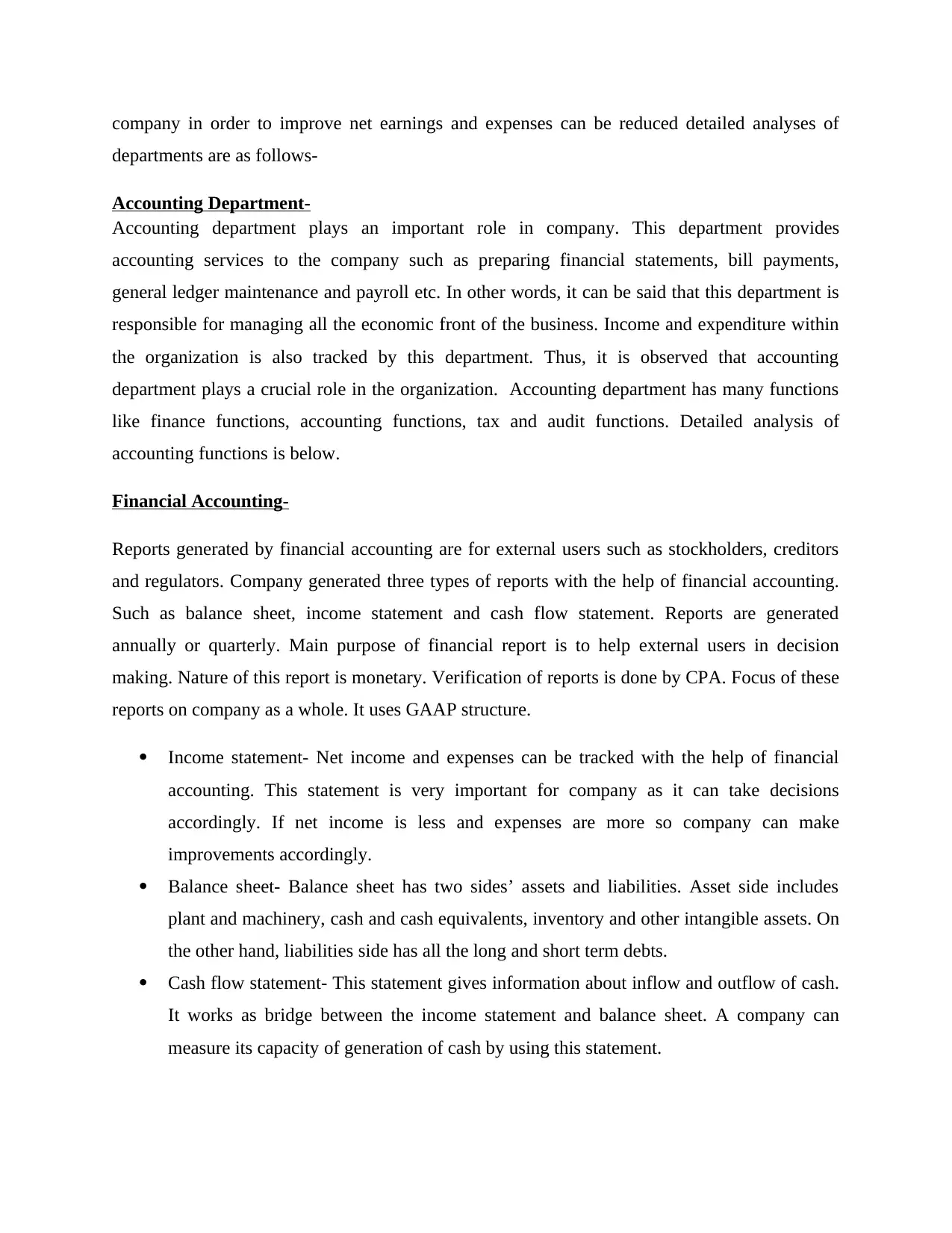
company in order to improve net earnings and expenses can be reduced detailed analyses of
departments are as follows-
Accounting Department-
Accounting department plays an important role in company. This department provides
accounting services to the company such as preparing financial statements, bill payments,
general ledger maintenance and payroll etc. In other words, it can be said that this department is
responsible for managing all the economic front of the business. Income and expenditure within
the organization is also tracked by this department. Thus, it is observed that accounting
department plays a crucial role in the organization. Accounting department has many functions
like finance functions, accounting functions, tax and audit functions. Detailed analysis of
accounting functions is below.
Financial Accounting-
Reports generated by financial accounting are for external users such as stockholders, creditors
and regulators. Company generated three types of reports with the help of financial accounting.
Such as balance sheet, income statement and cash flow statement. Reports are generated
annually or quarterly. Main purpose of financial report is to help external users in decision
making. Nature of this report is monetary. Verification of reports is done by CPA. Focus of these
reports on company as a whole. It uses GAAP structure.
Income statement- Net income and expenses can be tracked with the help of financial
accounting. This statement is very important for company as it can take decisions
accordingly. If net income is less and expenses are more so company can make
improvements accordingly.
Balance sheet- Balance sheet has two sides’ assets and liabilities. Asset side includes
plant and machinery, cash and cash equivalents, inventory and other intangible assets. On
the other hand, liabilities side has all the long and short term debts.
Cash flow statement- This statement gives information about inflow and outflow of cash.
It works as bridge between the income statement and balance sheet. A company can
measure its capacity of generation of cash by using this statement.
departments are as follows-
Accounting Department-
Accounting department plays an important role in company. This department provides
accounting services to the company such as preparing financial statements, bill payments,
general ledger maintenance and payroll etc. In other words, it can be said that this department is
responsible for managing all the economic front of the business. Income and expenditure within
the organization is also tracked by this department. Thus, it is observed that accounting
department plays a crucial role in the organization. Accounting department has many functions
like finance functions, accounting functions, tax and audit functions. Detailed analysis of
accounting functions is below.
Financial Accounting-
Reports generated by financial accounting are for external users such as stockholders, creditors
and regulators. Company generated three types of reports with the help of financial accounting.
Such as balance sheet, income statement and cash flow statement. Reports are generated
annually or quarterly. Main purpose of financial report is to help external users in decision
making. Nature of this report is monetary. Verification of reports is done by CPA. Focus of these
reports on company as a whole. It uses GAAP structure.
Income statement- Net income and expenses can be tracked with the help of financial
accounting. This statement is very important for company as it can take decisions
accordingly. If net income is less and expenses are more so company can make
improvements accordingly.
Balance sheet- Balance sheet has two sides’ assets and liabilities. Asset side includes
plant and machinery, cash and cash equivalents, inventory and other intangible assets. On
the other hand, liabilities side has all the long and short term debts.
Cash flow statement- This statement gives information about inflow and outflow of cash.
It works as bridge between the income statement and balance sheet. A company can
measure its capacity of generation of cash by using this statement.
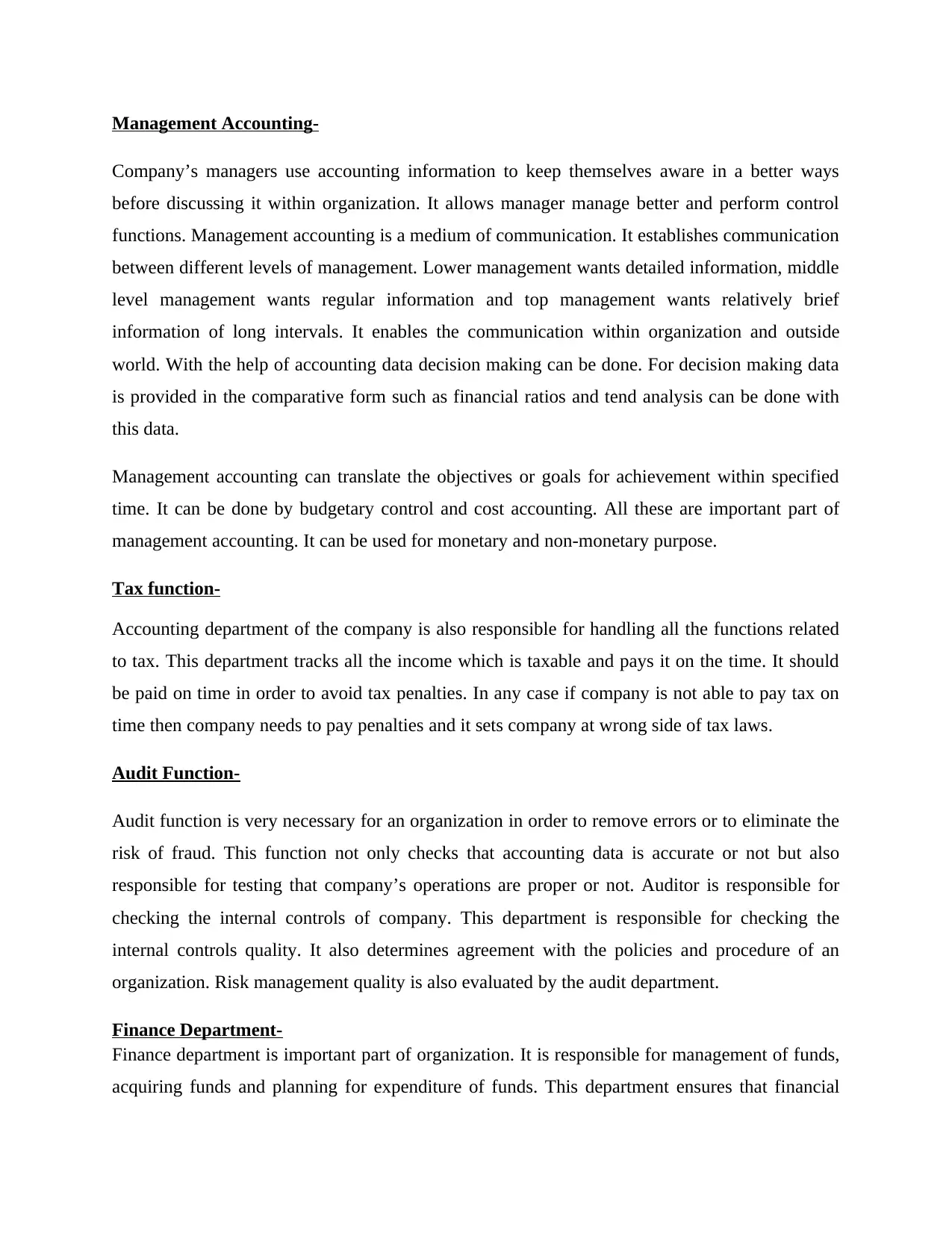
Management Accounting-
Company’s managers use accounting information to keep themselves aware in a better ways
before discussing it within organization. It allows manager manage better and perform control
functions. Management accounting is a medium of communication. It establishes communication
between different levels of management. Lower management wants detailed information, middle
level management wants regular information and top management wants relatively brief
information of long intervals. It enables the communication within organization and outside
world. With the help of accounting data decision making can be done. For decision making data
is provided in the comparative form such as financial ratios and tend analysis can be done with
this data.
Management accounting can translate the objectives or goals for achievement within specified
time. It can be done by budgetary control and cost accounting. All these are important part of
management accounting. It can be used for monetary and non-monetary purpose.
Tax function-
Accounting department of the company is also responsible for handling all the functions related
to tax. This department tracks all the income which is taxable and pays it on the time. It should
be paid on time in order to avoid tax penalties. In any case if company is not able to pay tax on
time then company needs to pay penalties and it sets company at wrong side of tax laws.
Audit Function-
Audit function is very necessary for an organization in order to remove errors or to eliminate the
risk of fraud. This function not only checks that accounting data is accurate or not but also
responsible for testing that company’s operations are proper or not. Auditor is responsible for
checking the internal controls of company. This department is responsible for checking the
internal controls quality. It also determines agreement with the policies and procedure of an
organization. Risk management quality is also evaluated by the audit department.
Finance Department-
Finance department is important part of organization. It is responsible for management of funds,
acquiring funds and planning for expenditure of funds. This department ensures that financial
Company’s managers use accounting information to keep themselves aware in a better ways
before discussing it within organization. It allows manager manage better and perform control
functions. Management accounting is a medium of communication. It establishes communication
between different levels of management. Lower management wants detailed information, middle
level management wants regular information and top management wants relatively brief
information of long intervals. It enables the communication within organization and outside
world. With the help of accounting data decision making can be done. For decision making data
is provided in the comparative form such as financial ratios and tend analysis can be done with
this data.
Management accounting can translate the objectives or goals for achievement within specified
time. It can be done by budgetary control and cost accounting. All these are important part of
management accounting. It can be used for monetary and non-monetary purpose.
Tax function-
Accounting department of the company is also responsible for handling all the functions related
to tax. This department tracks all the income which is taxable and pays it on the time. It should
be paid on time in order to avoid tax penalties. In any case if company is not able to pay tax on
time then company needs to pay penalties and it sets company at wrong side of tax laws.
Audit Function-
Audit function is very necessary for an organization in order to remove errors or to eliminate the
risk of fraud. This function not only checks that accounting data is accurate or not but also
responsible for testing that company’s operations are proper or not. Auditor is responsible for
checking the internal controls of company. This department is responsible for checking the
internal controls quality. It also determines agreement with the policies and procedure of an
organization. Risk management quality is also evaluated by the audit department.
Finance Department-
Finance department is important part of organization. It is responsible for management of funds,
acquiring funds and planning for expenditure of funds. This department ensures that financial
⊘ This is a preview!⊘
Do you want full access?
Subscribe today to unlock all pages.

Trusted by 1+ million students worldwide
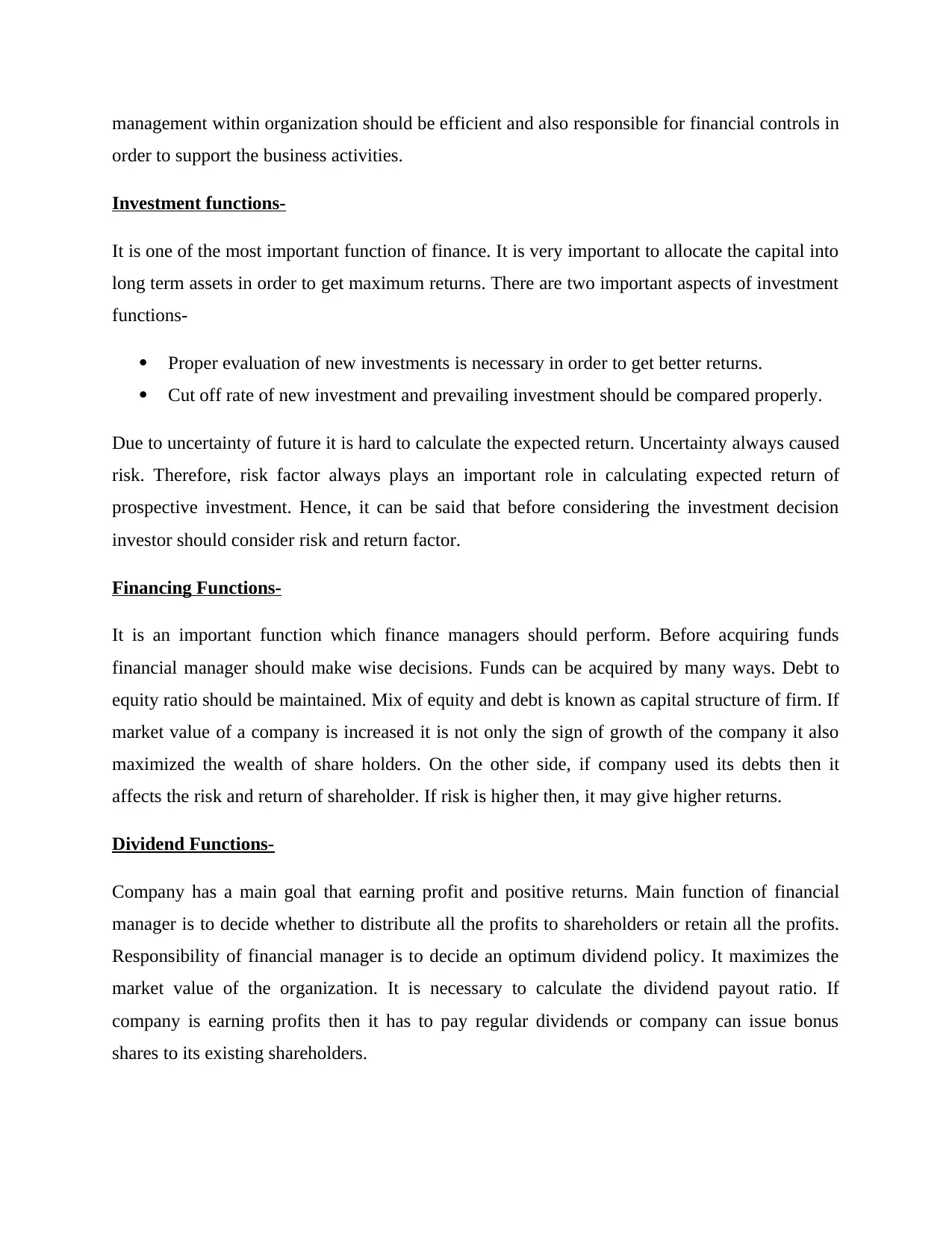
management within organization should be efficient and also responsible for financial controls in
order to support the business activities.
Investment functions-
It is one of the most important function of finance. It is very important to allocate the capital into
long term assets in order to get maximum returns. There are two important aspects of investment
functions-
Proper evaluation of new investments is necessary in order to get better returns.
Cut off rate of new investment and prevailing investment should be compared properly.
Due to uncertainty of future it is hard to calculate the expected return. Uncertainty always caused
risk. Therefore, risk factor always plays an important role in calculating expected return of
prospective investment. Hence, it can be said that before considering the investment decision
investor should consider risk and return factor.
Financing Functions-
It is an important function which finance managers should perform. Before acquiring funds
financial manager should make wise decisions. Funds can be acquired by many ways. Debt to
equity ratio should be maintained. Mix of equity and debt is known as capital structure of firm. If
market value of a company is increased it is not only the sign of growth of the company it also
maximized the wealth of share holders. On the other side, if company used its debts then it
affects the risk and return of shareholder. If risk is higher then, it may give higher returns.
Dividend Functions-
Company has a main goal that earning profit and positive returns. Main function of financial
manager is to decide whether to distribute all the profits to shareholders or retain all the profits.
Responsibility of financial manager is to decide an optimum dividend policy. It maximizes the
market value of the organization. It is necessary to calculate the dividend payout ratio. If
company is earning profits then it has to pay regular dividends or company can issue bonus
shares to its existing shareholders.
order to support the business activities.
Investment functions-
It is one of the most important function of finance. It is very important to allocate the capital into
long term assets in order to get maximum returns. There are two important aspects of investment
functions-
Proper evaluation of new investments is necessary in order to get better returns.
Cut off rate of new investment and prevailing investment should be compared properly.
Due to uncertainty of future it is hard to calculate the expected return. Uncertainty always caused
risk. Therefore, risk factor always plays an important role in calculating expected return of
prospective investment. Hence, it can be said that before considering the investment decision
investor should consider risk and return factor.
Financing Functions-
It is an important function which finance managers should perform. Before acquiring funds
financial manager should make wise decisions. Funds can be acquired by many ways. Debt to
equity ratio should be maintained. Mix of equity and debt is known as capital structure of firm. If
market value of a company is increased it is not only the sign of growth of the company it also
maximized the wealth of share holders. On the other side, if company used its debts then it
affects the risk and return of shareholder. If risk is higher then, it may give higher returns.
Dividend Functions-
Company has a main goal that earning profit and positive returns. Main function of financial
manager is to decide whether to distribute all the profits to shareholders or retain all the profits.
Responsibility of financial manager is to decide an optimum dividend policy. It maximizes the
market value of the organization. It is necessary to calculate the dividend payout ratio. If
company is earning profits then it has to pay regular dividends or company can issue bonus
shares to its existing shareholders.
Paraphrase This Document
Need a fresh take? Get an instant paraphrase of this document with our AI Paraphraser
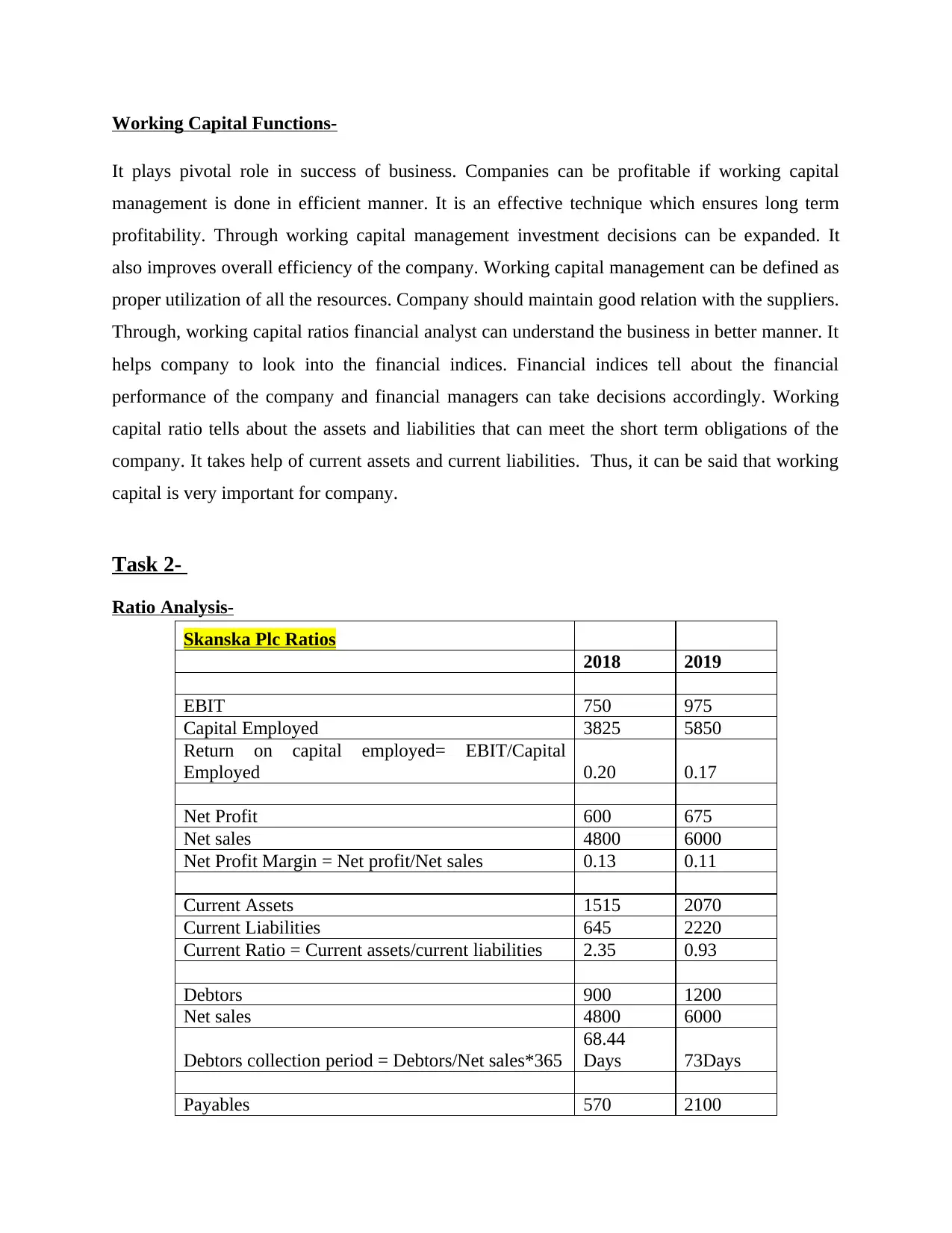
Working Capital Functions-
It plays pivotal role in success of business. Companies can be profitable if working capital
management is done in efficient manner. It is an effective technique which ensures long term
profitability. Through working capital management investment decisions can be expanded. It
also improves overall efficiency of the company. Working capital management can be defined as
proper utilization of all the resources. Company should maintain good relation with the suppliers.
Through, working capital ratios financial analyst can understand the business in better manner. It
helps company to look into the financial indices. Financial indices tell about the financial
performance of the company and financial managers can take decisions accordingly. Working
capital ratio tells about the assets and liabilities that can meet the short term obligations of the
company. It takes help of current assets and current liabilities. Thus, it can be said that working
capital is very important for company.
Task 2-
Ratio Analysis-
Skanska Plc Ratios
2018 2019
EBIT 750 975
Capital Employed 3825 5850
Return on capital employed= EBIT/Capital
Employed 0.20 0.17
Net Profit 600 675
Net sales 4800 6000
Net Profit Margin = Net profit/Net sales 0.13 0.11
Current Assets 1515 2070
Current Liabilities 645 2220
Current Ratio = Current assets/current liabilities 2.35 0.93
Debtors 900 1200
Net sales 4800 6000
Debtors collection period = Debtors/Net sales*365
68.44
Days 73Days
Payables 570 2100
It plays pivotal role in success of business. Companies can be profitable if working capital
management is done in efficient manner. It is an effective technique which ensures long term
profitability. Through working capital management investment decisions can be expanded. It
also improves overall efficiency of the company. Working capital management can be defined as
proper utilization of all the resources. Company should maintain good relation with the suppliers.
Through, working capital ratios financial analyst can understand the business in better manner. It
helps company to look into the financial indices. Financial indices tell about the financial
performance of the company and financial managers can take decisions accordingly. Working
capital ratio tells about the assets and liabilities that can meet the short term obligations of the
company. It takes help of current assets and current liabilities. Thus, it can be said that working
capital is very important for company.
Task 2-
Ratio Analysis-
Skanska Plc Ratios
2018 2019
EBIT 750 975
Capital Employed 3825 5850
Return on capital employed= EBIT/Capital
Employed 0.20 0.17
Net Profit 600 675
Net sales 4800 6000
Net Profit Margin = Net profit/Net sales 0.13 0.11
Current Assets 1515 2070
Current Liabilities 645 2220
Current Ratio = Current assets/current liabilities 2.35 0.93
Debtors 900 1200
Net sales 4800 6000
Debtors collection period = Debtors/Net sales*365
68.44
Days 73Days
Payables 570 2100
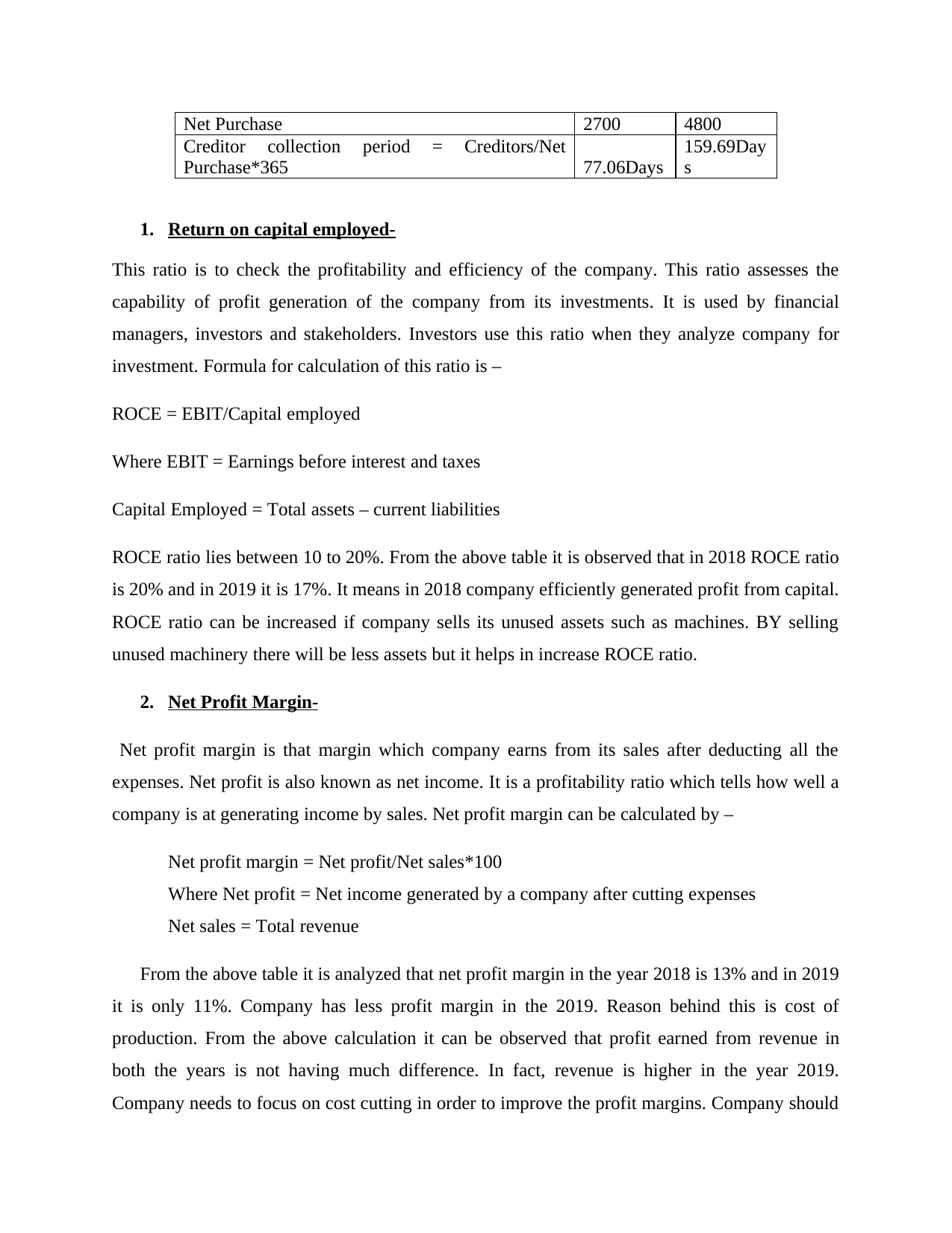
Net Purchase 2700 4800
Creditor collection period = Creditors/Net
Purchase*365 77.06Days
159.69Day
s
1. Return on capital employed-
This ratio is to check the profitability and efficiency of the company. This ratio assesses the
capability of profit generation of the company from its investments. It is used by financial
managers, investors and stakeholders. Investors use this ratio when they analyze company for
investment. Formula for calculation of this ratio is –
ROCE = EBIT/Capital employed
Where EBIT = Earnings before interest and taxes
Capital Employed = Total assets – current liabilities
ROCE ratio lies between 10 to 20%. From the above table it is observed that in 2018 ROCE ratio
is 20% and in 2019 it is 17%. It means in 2018 company efficiently generated profit from capital.
ROCE ratio can be increased if company sells its unused assets such as machines. BY selling
unused machinery there will be less assets but it helps in increase ROCE ratio.
2. Net Profit Margin-
Net profit margin is that margin which company earns from its sales after deducting all the
expenses. Net profit is also known as net income. It is a profitability ratio which tells how well a
company is at generating income by sales. Net profit margin can be calculated by –
Net profit margin = Net profit/Net sales*100
Where Net profit = Net income generated by a company after cutting expenses
Net sales = Total revenue
From the above table it is analyzed that net profit margin in the year 2018 is 13% and in 2019
it is only 11%. Company has less profit margin in the 2019. Reason behind this is cost of
production. From the above calculation it can be observed that profit earned from revenue in
both the years is not having much difference. In fact, revenue is higher in the year 2019.
Company needs to focus on cost cutting in order to improve the profit margins. Company should
Creditor collection period = Creditors/Net
Purchase*365 77.06Days
159.69Day
s
1. Return on capital employed-
This ratio is to check the profitability and efficiency of the company. This ratio assesses the
capability of profit generation of the company from its investments. It is used by financial
managers, investors and stakeholders. Investors use this ratio when they analyze company for
investment. Formula for calculation of this ratio is –
ROCE = EBIT/Capital employed
Where EBIT = Earnings before interest and taxes
Capital Employed = Total assets – current liabilities
ROCE ratio lies between 10 to 20%. From the above table it is observed that in 2018 ROCE ratio
is 20% and in 2019 it is 17%. It means in 2018 company efficiently generated profit from capital.
ROCE ratio can be increased if company sells its unused assets such as machines. BY selling
unused machinery there will be less assets but it helps in increase ROCE ratio.
2. Net Profit Margin-
Net profit margin is that margin which company earns from its sales after deducting all the
expenses. Net profit is also known as net income. It is a profitability ratio which tells how well a
company is at generating income by sales. Net profit margin can be calculated by –
Net profit margin = Net profit/Net sales*100
Where Net profit = Net income generated by a company after cutting expenses
Net sales = Total revenue
From the above table it is analyzed that net profit margin in the year 2018 is 13% and in 2019
it is only 11%. Company has less profit margin in the 2019. Reason behind this is cost of
production. From the above calculation it can be observed that profit earned from revenue in
both the years is not having much difference. In fact, revenue is higher in the year 2019.
Company needs to focus on cost cutting in order to improve the profit margins. Company should
⊘ This is a preview!⊘
Do you want full access?
Subscribe today to unlock all pages.

Trusted by 1+ million students worldwide
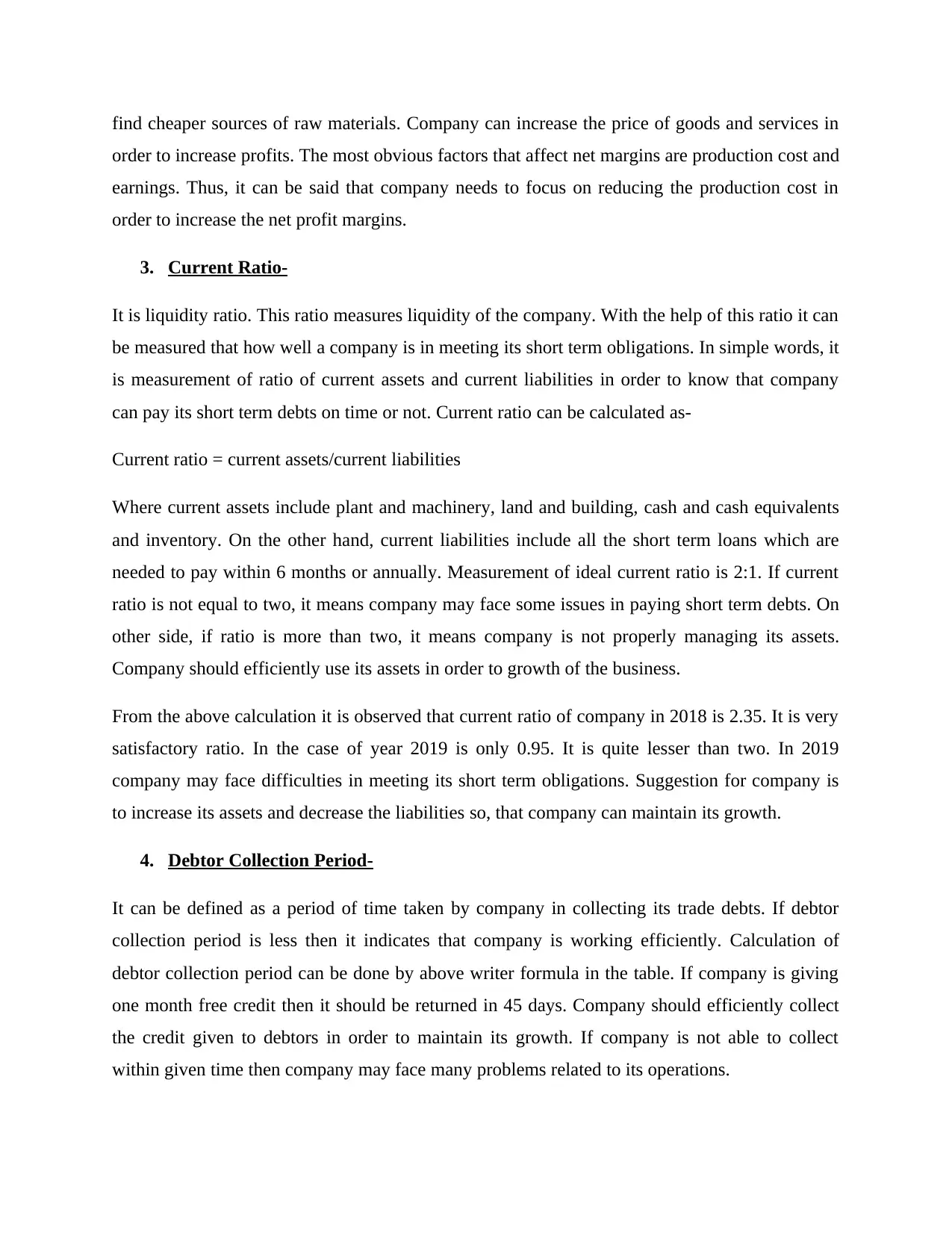
find cheaper sources of raw materials. Company can increase the price of goods and services in
order to increase profits. The most obvious factors that affect net margins are production cost and
earnings. Thus, it can be said that company needs to focus on reducing the production cost in
order to increase the net profit margins.
3. Current Ratio-
It is liquidity ratio. This ratio measures liquidity of the company. With the help of this ratio it can
be measured that how well a company is in meeting its short term obligations. In simple words, it
is measurement of ratio of current assets and current liabilities in order to know that company
can pay its short term debts on time or not. Current ratio can be calculated as-
Current ratio = current assets/current liabilities
Where current assets include plant and machinery, land and building, cash and cash equivalents
and inventory. On the other hand, current liabilities include all the short term loans which are
needed to pay within 6 months or annually. Measurement of ideal current ratio is 2:1. If current
ratio is not equal to two, it means company may face some issues in paying short term debts. On
other side, if ratio is more than two, it means company is not properly managing its assets.
Company should efficiently use its assets in order to growth of the business.
From the above calculation it is observed that current ratio of company in 2018 is 2.35. It is very
satisfactory ratio. In the case of year 2019 is only 0.95. It is quite lesser than two. In 2019
company may face difficulties in meeting its short term obligations. Suggestion for company is
to increase its assets and decrease the liabilities so, that company can maintain its growth.
4. Debtor Collection Period-
It can be defined as a period of time taken by company in collecting its trade debts. If debtor
collection period is less then it indicates that company is working efficiently. Calculation of
debtor collection period can be done by above writer formula in the table. If company is giving
one month free credit then it should be returned in 45 days. Company should efficiently collect
the credit given to debtors in order to maintain its growth. If company is not able to collect
within given time then company may face many problems related to its operations.
order to increase profits. The most obvious factors that affect net margins are production cost and
earnings. Thus, it can be said that company needs to focus on reducing the production cost in
order to increase the net profit margins.
3. Current Ratio-
It is liquidity ratio. This ratio measures liquidity of the company. With the help of this ratio it can
be measured that how well a company is in meeting its short term obligations. In simple words, it
is measurement of ratio of current assets and current liabilities in order to know that company
can pay its short term debts on time or not. Current ratio can be calculated as-
Current ratio = current assets/current liabilities
Where current assets include plant and machinery, land and building, cash and cash equivalents
and inventory. On the other hand, current liabilities include all the short term loans which are
needed to pay within 6 months or annually. Measurement of ideal current ratio is 2:1. If current
ratio is not equal to two, it means company may face some issues in paying short term debts. On
other side, if ratio is more than two, it means company is not properly managing its assets.
Company should efficiently use its assets in order to growth of the business.
From the above calculation it is observed that current ratio of company in 2018 is 2.35. It is very
satisfactory ratio. In the case of year 2019 is only 0.95. It is quite lesser than two. In 2019
company may face difficulties in meeting its short term obligations. Suggestion for company is
to increase its assets and decrease the liabilities so, that company can maintain its growth.
4. Debtor Collection Period-
It can be defined as a period of time taken by company in collecting its trade debts. If debtor
collection period is less then it indicates that company is working efficiently. Calculation of
debtor collection period can be done by above writer formula in the table. If company is giving
one month free credit then it should be returned in 45 days. Company should efficiently collect
the credit given to debtors in order to maintain its growth. If company is not able to collect
within given time then company may face many problems related to its operations.
Paraphrase This Document
Need a fresh take? Get an instant paraphrase of this document with our AI Paraphraser
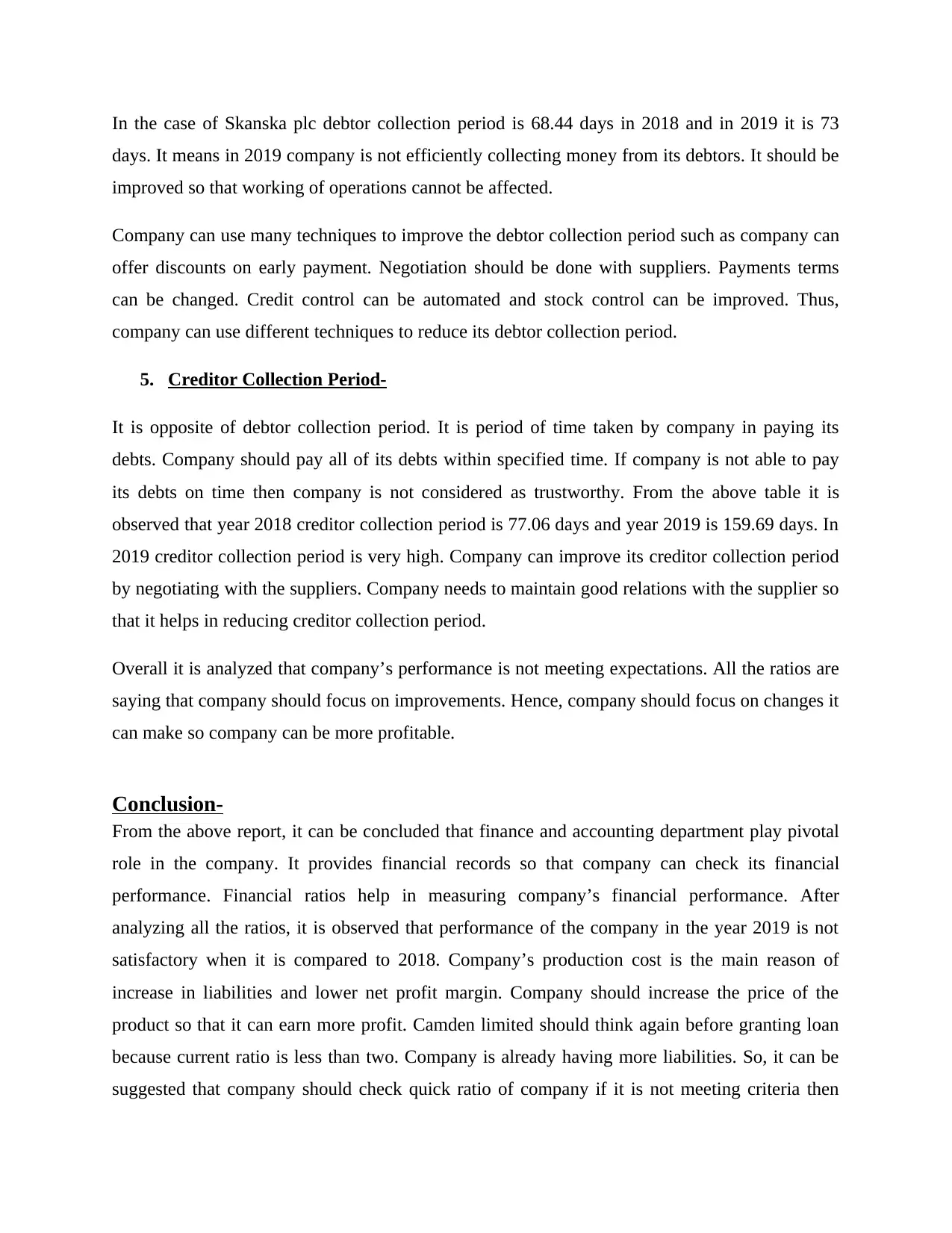
In the case of Skanska plc debtor collection period is 68.44 days in 2018 and in 2019 it is 73
days. It means in 2019 company is not efficiently collecting money from its debtors. It should be
improved so that working of operations cannot be affected.
Company can use many techniques to improve the debtor collection period such as company can
offer discounts on early payment. Negotiation should be done with suppliers. Payments terms
can be changed. Credit control can be automated and stock control can be improved. Thus,
company can use different techniques to reduce its debtor collection period.
5. Creditor Collection Period-
It is opposite of debtor collection period. It is period of time taken by company in paying its
debts. Company should pay all of its debts within specified time. If company is not able to pay
its debts on time then company is not considered as trustworthy. From the above table it is
observed that year 2018 creditor collection period is 77.06 days and year 2019 is 159.69 days. In
2019 creditor collection period is very high. Company can improve its creditor collection period
by negotiating with the suppliers. Company needs to maintain good relations with the supplier so
that it helps in reducing creditor collection period.
Overall it is analyzed that company’s performance is not meeting expectations. All the ratios are
saying that company should focus on improvements. Hence, company should focus on changes it
can make so company can be more profitable.
Conclusion-
From the above report, it can be concluded that finance and accounting department play pivotal
role in the company. It provides financial records so that company can check its financial
performance. Financial ratios help in measuring company’s financial performance. After
analyzing all the ratios, it is observed that performance of the company in the year 2019 is not
satisfactory when it is compared to 2018. Company’s production cost is the main reason of
increase in liabilities and lower net profit margin. Company should increase the price of the
product so that it can earn more profit. Camden limited should think again before granting loan
because current ratio is less than two. Company is already having more liabilities. So, it can be
suggested that company should check quick ratio of company if it is not meeting criteria then
days. It means in 2019 company is not efficiently collecting money from its debtors. It should be
improved so that working of operations cannot be affected.
Company can use many techniques to improve the debtor collection period such as company can
offer discounts on early payment. Negotiation should be done with suppliers. Payments terms
can be changed. Credit control can be automated and stock control can be improved. Thus,
company can use different techniques to reduce its debtor collection period.
5. Creditor Collection Period-
It is opposite of debtor collection period. It is period of time taken by company in paying its
debts. Company should pay all of its debts within specified time. If company is not able to pay
its debts on time then company is not considered as trustworthy. From the above table it is
observed that year 2018 creditor collection period is 77.06 days and year 2019 is 159.69 days. In
2019 creditor collection period is very high. Company can improve its creditor collection period
by negotiating with the suppliers. Company needs to maintain good relations with the supplier so
that it helps in reducing creditor collection period.
Overall it is analyzed that company’s performance is not meeting expectations. All the ratios are
saying that company should focus on improvements. Hence, company should focus on changes it
can make so company can be more profitable.
Conclusion-
From the above report, it can be concluded that finance and accounting department play pivotal
role in the company. It provides financial records so that company can check its financial
performance. Financial ratios help in measuring company’s financial performance. After
analyzing all the ratios, it is observed that performance of the company in the year 2019 is not
satisfactory when it is compared to 2018. Company’s production cost is the main reason of
increase in liabilities and lower net profit margin. Company should increase the price of the
product so that it can earn more profit. Camden limited should think again before granting loan
because current ratio is less than two. Company is already having more liabilities. So, it can be
suggested that company should check quick ratio of company if it is not meeting criteria then
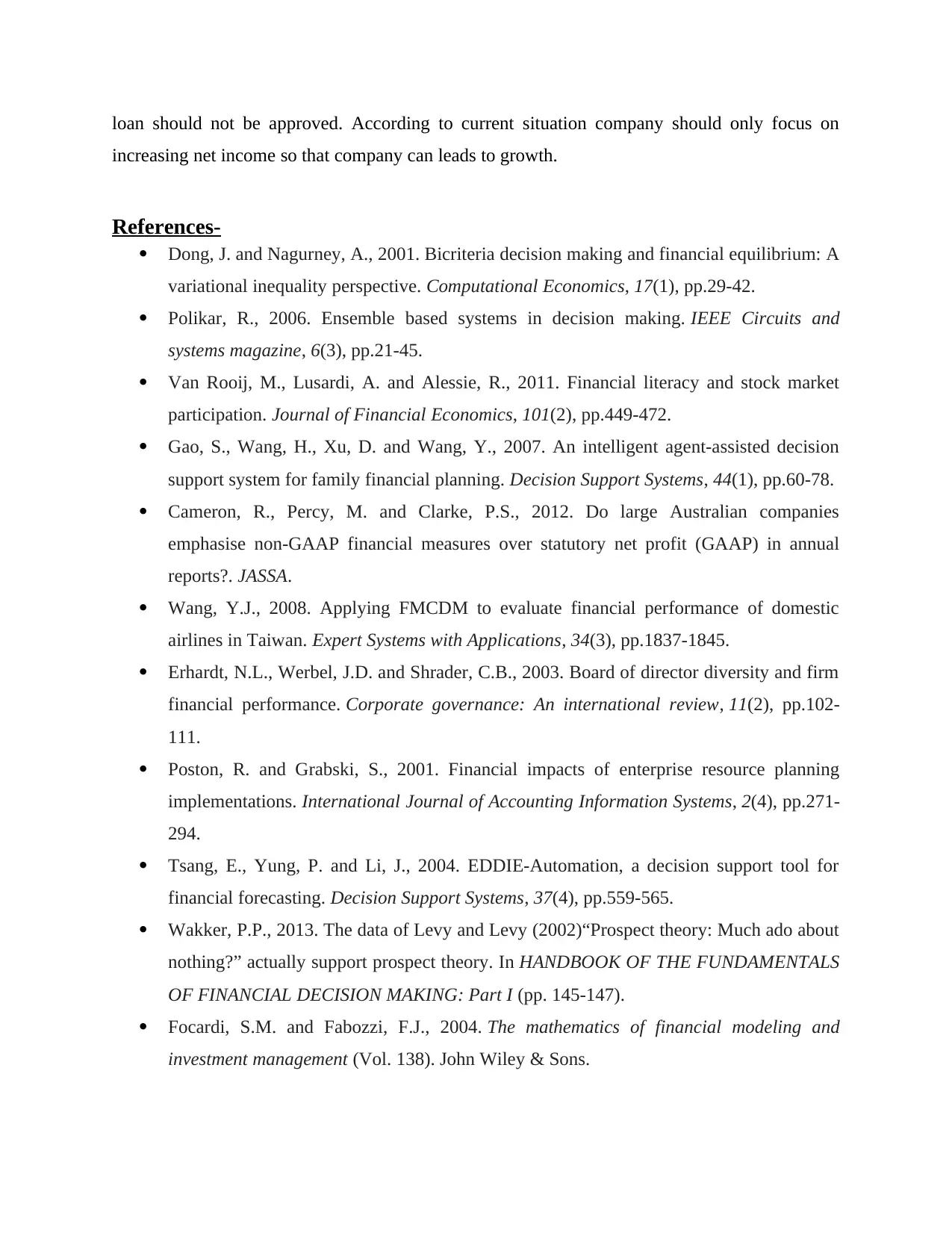
loan should not be approved. According to current situation company should only focus on
increasing net income so that company can leads to growth.
References-
Dong, J. and Nagurney, A., 2001. Bicriteria decision making and financial equilibrium: A
variational inequality perspective. Computational Economics, 17(1), pp.29-42.
Polikar, R., 2006. Ensemble based systems in decision making. IEEE Circuits and
systems magazine, 6(3), pp.21-45.
Van Rooij, M., Lusardi, A. and Alessie, R., 2011. Financial literacy and stock market
participation. Journal of Financial Economics, 101(2), pp.449-472.
Gao, S., Wang, H., Xu, D. and Wang, Y., 2007. An intelligent agent-assisted decision
support system for family financial planning. Decision Support Systems, 44(1), pp.60-78.
Cameron, R., Percy, M. and Clarke, P.S., 2012. Do large Australian companies
emphasise non-GAAP financial measures over statutory net profit (GAAP) in annual
reports?. JASSA.
Wang, Y.J., 2008. Applying FMCDM to evaluate financial performance of domestic
airlines in Taiwan. Expert Systems with Applications, 34(3), pp.1837-1845.
Erhardt, N.L., Werbel, J.D. and Shrader, C.B., 2003. Board of director diversity and firm
financial performance. Corporate governance: An international review, 11(2), pp.102-
111.
Poston, R. and Grabski, S., 2001. Financial impacts of enterprise resource planning
implementations. International Journal of Accounting Information Systems, 2(4), pp.271-
294.
Tsang, E., Yung, P. and Li, J., 2004. EDDIE-Automation, a decision support tool for
financial forecasting. Decision Support Systems, 37(4), pp.559-565.
Wakker, P.P., 2013. The data of Levy and Levy (2002)“Prospect theory: Much ado about
nothing?” actually support prospect theory. In HANDBOOK OF THE FUNDAMENTALS
OF FINANCIAL DECISION MAKING: Part I (pp. 145-147).
Focardi, S.M. and Fabozzi, F.J., 2004. The mathematics of financial modeling and
investment management (Vol. 138). John Wiley & Sons.
increasing net income so that company can leads to growth.
References-
Dong, J. and Nagurney, A., 2001. Bicriteria decision making and financial equilibrium: A
variational inequality perspective. Computational Economics, 17(1), pp.29-42.
Polikar, R., 2006. Ensemble based systems in decision making. IEEE Circuits and
systems magazine, 6(3), pp.21-45.
Van Rooij, M., Lusardi, A. and Alessie, R., 2011. Financial literacy and stock market
participation. Journal of Financial Economics, 101(2), pp.449-472.
Gao, S., Wang, H., Xu, D. and Wang, Y., 2007. An intelligent agent-assisted decision
support system for family financial planning. Decision Support Systems, 44(1), pp.60-78.
Cameron, R., Percy, M. and Clarke, P.S., 2012. Do large Australian companies
emphasise non-GAAP financial measures over statutory net profit (GAAP) in annual
reports?. JASSA.
Wang, Y.J., 2008. Applying FMCDM to evaluate financial performance of domestic
airlines in Taiwan. Expert Systems with Applications, 34(3), pp.1837-1845.
Erhardt, N.L., Werbel, J.D. and Shrader, C.B., 2003. Board of director diversity and firm
financial performance. Corporate governance: An international review, 11(2), pp.102-
111.
Poston, R. and Grabski, S., 2001. Financial impacts of enterprise resource planning
implementations. International Journal of Accounting Information Systems, 2(4), pp.271-
294.
Tsang, E., Yung, P. and Li, J., 2004. EDDIE-Automation, a decision support tool for
financial forecasting. Decision Support Systems, 37(4), pp.559-565.
Wakker, P.P., 2013. The data of Levy and Levy (2002)“Prospect theory: Much ado about
nothing?” actually support prospect theory. In HANDBOOK OF THE FUNDAMENTALS
OF FINANCIAL DECISION MAKING: Part I (pp. 145-147).
Focardi, S.M. and Fabozzi, F.J., 2004. The mathematics of financial modeling and
investment management (Vol. 138). John Wiley & Sons.
⊘ This is a preview!⊘
Do you want full access?
Subscribe today to unlock all pages.

Trusted by 1+ million students worldwide
1 out of 13
Related Documents
Your All-in-One AI-Powered Toolkit for Academic Success.
+13062052269
info@desklib.com
Available 24*7 on WhatsApp / Email
![[object Object]](/_next/static/media/star-bottom.7253800d.svg)
Unlock your academic potential
Copyright © 2020–2025 A2Z Services. All Rights Reserved. Developed and managed by ZUCOL.





